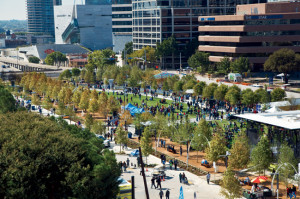by LAURA MIRVISS, Architectural Record, August 2013

The ambitious Klyde Warren Park covers a 1,200-foot-long stretch of the Woodall Rodgers Freeway. A serene, 2,400-square-foot concert pavilion by Thomas Phifer and Partners is open on all sides
Photo: Dillon Diers Photography
Source: www.archrecord.construction.com
Decked out in Dallas: A sprawling rectangular park on top of a major freeway unites an up-and-coming residential neighborhood with the burgeoning Arts District.
As in many American cities, large highways slice through downtown Dallas. Sidewalks seem intermittent, parking lots abundant, and locals respond with strange looks when asked the best way to walk to a nearby bar or restaurant.
But Dallas is pouring millions of dollars into changing all that. In the past decade, the city has quietly inserted a handful of small green gardens between downtown office towers and condos, providing small reprieves from the expanses of asphalt and concrete. As part of this initiative, over ten years ago, local civic leaders began talking to a team of designers and engineers about coming up with a scheme for uniting the city’s fractured downtown by covering over an existing freeway with a park.
Now, $110 million later, the design team, Jacobs Engineering Group, along with landscape architect The Office of James Burnett, has delivered something radical—5.2 acres of green space laid across an eight-lane highway. The Woodall Rodgers Freeway, oriented northeast-southwest and depressed to minimize traffic noise, ran underneath a number of perpendicular at-grade bridges used as cross streets. The park now fills the gaps between the bridges to create a 1,200-by-200-foot three-block-long deck between Pearl and St. Paul streets. “You only realize you’re near a freeway at the ends of the park,” says principal James Burnett. “You can’t hear the roar of traffic below.”
A major structural challenge was designing an at-grade park—where visitors enter from surrounding streets without ascending steps or ramps—that also met the state highway height clearance requirement of 16.5 feet. The 6.5-foot-deep park deck, braced on concrete walls along the sides and on the median strip of the highway, consists of three 100-foot-long pre-stressed concrete box beams that alternate with 4.5-foot-deep concrete trenches for trees, plumbing, and electrical equipment in an abbba pattern. Geofoam, a dense Styrofoam-like fill, lightens the load wherever soil is not needed, and the entire park is covered in a 6- to 18-inch layer of topsoil.
Klyde Warren Park, named for the 10-year-old son of park patron and billionaire energy magnate Kelcy Warren, was funded through a public-private partnership, with more than $50 million in private donations and nearly $60 million in city, state, and federal funding. The park is filled with amenities funded by Warren and other private donors: a playground, dog park, water features, gardens, walking paths, and a Thomas Phifer–designed concert stage and restaurant. (The restaurant is scheduled to open in the fall.) The park accommodates yoga classes, croquet, Pétanque, Ping-Pong, birthday parties—and more. While the designers would have liked to have a continuous three-block-long green, politics intervened. One cross street, open to traffic, divides the park into two segments—a two-block swath and a one-block section.
The gently sloping park skims right past the Dallas Arts District, so pedestrians can easily veer off the greensward to visit the Dallas Museum of Art and the Nasher Sculpture Center, among other cultural entities. The project’s success has far exceeded projections, with attendance averaging 12,000 to 15,000 visits per week. Food trucks have been a huge hit, particularly with office workers, and new paving recently was added on the southwest side to handle the extra foot traffic. Says Burnett, “Dallas was starved for this kind of urban amenity, and now it’s got it.”
Watch video from Chamberlin Roofing and Waterproofing website